Citizen Science from the Perspective of Higher Education Professors
Abstract
1. Introduction
2. Materials and Methods
2.1. Study Objectives and Research Hypothesis
2.2. Data Collection Procedure
2.3. Data Analysis
3. Results and Discussion
3.1. Sociodemographic and Socioprofessional Characteristics of the Study Participants
3.2. Analysis of General Characteristics of Citizen Science
3.2.1. Participants’ Perceptions of Concepts and Participation in Citizen Science
3.2.2. Participants’ Perceptions of Citizen Science and Citizen Scientists
3.2.3. Perceptions of the Importance of Citizen Science
3.2.4. Relationships Between Perceptions of Citizen Science Concepts, Citizen Scientists, and the Perceived Importance of Citizen Science
3.3. Analysis of Specific Characteristics of Citizen Science
3.3.1. Perceptions About Level of Public Engagement in Citizen Science
3.3.2. Perceptions of the Most Effective Methods for Communicating and Transmitting Data Produced by Citizen Scientists
3.3.3. Participants’ Perceptions Regarding the Use and Dissemination of Data Obtained Through Citizen Science
3.3.4. Perceptions of How Volunteer Participation (Citizen Scientists) Is Acknowledged in Scientific Publications
3.3.5. Perceptions of Priority Audience Types for Participation in Citizen Science Projects
3.3.6. Perceptions of Training and Qualification Methods for Citizen Scientists
3.3.7. Perceptions About Preferences for Data Collection Methods Used by Citizen Scientists
3.3.8. Perceptions of Methods and Tools Used to Evaluate the Efficiency of Citizen Scientists
3.3.9. Perceptions Regarding the Need for the Validation of Data Collected by Citizen Scientists by Professional Scientists
4. Conclusions
5. Limitations and Future Perspectives
5.1. Limitations
5.2. Future Perspectives
Supplementary Materials
Author Contributions
Funding
Institutional Review Board Statement
Informed Consent Statement
Data Availability Statement
Acknowledgments
Conflicts of Interest
Abbreviations
| CS | Citizen Science |
| EBTT | Higher Education or Basic, Technical, and Technological Education |
| IBGE | Brazilian Institute of Geography and Statistics |
| ICF | Informed Consent Form |
| MEC | Ministry of Education |
| OPAL | Open-Air Laboratory |
| Portable Document Format | |
| PhD | Doctorate |
| REC | Research Ethics Committee |
| UNESCO | United Nations Educational, Scientific, and Cultural Organization |
References
- Akpan, D. M. (2024). Excel: VLOOKUP, tabelas dinâmicas e SQL. In Future-proof accounting (pp. 95–127). Emerald Publishing Limited. [Google Scholar] [CrossRef]
- Albagli, S., Clinio, A., & Raychtock, S. (2014). Ciência Aberta: Correntes interpretativas e tipos de ação|Open Science: Interpretive trends and types of action. Liinc em Revista, 10(2), 434–450. [Google Scholar] [CrossRef]
- Albagli, S., & Iwama, A. Y. (2022). Citizen science and the right to research: Building local knowledge of climate change impacts. Humanities and Social Sciences Communications, 9(1), 39. [Google Scholar] [CrossRef]
- Almeida, A. M. F., & Érnica, M. (2016). International faculty in a Brazilian university: International trajectories in a nationalized system of scientific production. In International faculty in higher education (pp. 42–60). Routledge. [Google Scholar] [CrossRef]
- Arantes, P. F. (2021). Higher education in dark times: From the democratic renewal of Brazilian universities to its current wreck. Policy Reviews in Higher Education, 5(2), 131–157. [Google Scholar] [CrossRef]
- Aristeidou, M., & Herodotou, C. (2020). Online citizen science: A systematic review of effects on learning and scientific literacy. Citizen Science: Theory and Practice, 5(1), 1–12. [Google Scholar] [CrossRef]
- Aristeidou, M., Herodotou, C., Ballard, H. L., Higgins, L., Johnson, R. F., Miller, A. E., Young, A. N., & Robinson, L. D. (2021). How do young community and citizen science volunteers support scientific research on biodiversity? The case of iNaturalist. Diversity, 13(7), 318. [Google Scholar] [CrossRef]
- Aristeidou, M., Scanlon, E., & Sharples, M. (2017). Profiles of engagement in online communities of citizen science participation. Computers in Human Behavior, 74, 246–256. [Google Scholar] [CrossRef]
- Arza, V., & Fressoli, M. (2017). Sistematizando benefícios de práticas de ciência aberta. Information Services & Use, 37(4), 463–474. [Google Scholar] [CrossRef]
- Asaie, M. (2024). Exploring TEFL research methods courses in Iran: A path to research synthesis pedagogy. The Qualitative Report, 29(1), 206–228. [Google Scholar] [CrossRef]
- Baker, E., Drury, J. P., Judge, J., Roy, D. B., Smith, G. C., & Stephens, P. A. (2021). The verification of ecological citizen science data: Current approaches and future possibilities. Citizen Science: Theory and Practice, 6(1), 12. [Google Scholar] [CrossRef]
- Balázs, B., Mooney, P., Nováková, E., Bastin, L., & Arsanjani, J. J. (2021). Data quality in citizen science. In The science of citizen science (pp. 139–157). Springer. [Google Scholar] [CrossRef]
- Bandara, W., Furtmueller, E., Gorbacheva, E., Miskon, S., & Beekhuyzen, J. (2015). Achieving rigor in literature reviews: Insights from qualitative data analysis and tool-support. Communications of the Association for Information Systems, 37(1), 8. [Google Scholar] [CrossRef]
- Barbato, D., Benocci, A., Bratto, C., & Manganelli, G. (2024). Reconnecting communities to urban nature: Insights from the Siena BiodiverCity project. In ECSA 2024 conference—Vienna 3–6 April—Book of abstract (p. 31). ECSA. Available online: https://hdl.handle.net/11365/1262098 (accessed on 24 November 2024).
- Becker-Klein, R., Peterman, K., & Stylinski, C. (2016). Embedded assessment as an essential method for understanding public engagement in citizen science. Citizen Science: Theory and Practice, 1(1), 8. [Google Scholar] [CrossRef]
- Beigel, F., Almeida, A. M., Gallardo, O., Digiampietri, L., Gomez, S., Candido, M. R., Ciriza, A., Rossomando, P., & Pecheny, M. e. M. (2023). Scientific production and gender inequalities in two academic elites: Brazil and Argentina. Revue d’Histoire des Sciences Humaines, 42, 255–280. [Google Scholar] [CrossRef]
- Bernier, N. F., & Clavier, C. (2011). Public health policy research: Making the case for a political science approach. Health Promotion International, 26(1), 109–116. [Google Scholar] [CrossRef] [PubMed]
- Besançon, L., Peiffer-Smadja, N., Segalas, C., Jiang, H., Masuzzo, P., Smout, C., Billy, E., Deforet, M., & Leyrat, C. (2021). Open science saves lives: Lessons from the COVID-19 pandemic. BMC Medical Research Methodology, 21(1), 117. [Google Scholar] [CrossRef]
- Besley, J. C., & Nisbet, M. (2013). How scientists view the public, the media and the political process. Public Understanding of Science, 22(6), 644–659. [Google Scholar] [CrossRef]
- Bonney, R., Cooper, C. B., Dickinson, J., Kelling, S., Phillips, T., Rosenberg, K. V., & Shirk, J. (2009). Citizen science: A developing tool for expanding science knowledge and scientific literacy. BioScience, 59(11), 977–984. [Google Scholar] [CrossRef]
- Bonney, R., Phillips, T. B., Ballard, H. L., & Enck, J. W. (2016). Can citizen science enhance public understanding of science? Public Understanding of Science, 25(1), 2–16. [Google Scholar] [CrossRef]
- Bosso, L., Panzuto, R., Balestrieri, R., Smeraldo, S., Chiusano, M. L., Raffini, F., Canestrelli, D., Musco, L., & Gili, C. (2024). Integrating citizen science and spatial ecology to inform management and conservation of the Italian seahorses. Ecological Informatics, 79, 102402. [Google Scholar] [CrossRef]
- Bowser, A., Shilton, K., Preece, J., & Warrick, E. (2017, February 25–March 1). Accounting for privacy in citizen science: Ethical research in a context of openness. CSCW ’17: Proceedings of the 2017 ACM Conference on Computer Supported Cooperative Work and Social Computing (pp. 2124–2136), Portland, OR, USA. [Google Scholar] [CrossRef]
- Brito, C., Barbosa, M. C., Pavani, D. B., Costa, A. B., & Nardi, H. C. (2022). Harassment in Brazilian universities: How big is this problem? The Federal University of Rio Grande do Sul (UFRGS) as a case study. Anais da Academia Brasileira de Ciências, 94, e20201720. [Google Scholar] [CrossRef]
- Brossard, D., Lewenstein, B., & Bonney, R. (2005). Scientific knowledge and attitude change: The impact of a citizen science project. International Journal of Science Education, 27(9), 1099–1121. [Google Scholar] [CrossRef]
- Brown, E. D., & Williams, B. K. (2019). The potential for citizen science to produce reliable and useful information in ecology. Conservation Biology, 33(3), 561–569. [Google Scholar] [CrossRef] [PubMed]
- Burchell, K. (2015). Factors affecting public engagement by researchers: Literature review. Available online: https://wellcome.ac.uk/sites/default/files/wtp060036.pdf (accessed on 10 November 2024).
- Burgess, H. K., DeBey, L. B., Froehlich, H. E., Schmidt, N., Theobald, E. J., Ettinger, A. K., HilleRisLambers, J., Tewksbury, J., & Parrish, J. K. (2017). The science of citizen science: Exploring barriers to use as a primary research tool. Biological Conservation, 208, 113–120. [Google Scholar] [CrossRef]
- Butkevičienė, E., Pučėtaitė, R., Budrytė, P., Vaičiūnienė, J., Norvoll, R., Canto, P., Lorenz, U., Juricek, S., Freiling, I., Matthes, J., Jørgensen, M. S., Pataki, G., Czeglédi, A., Gatti, F., & Procentese, F. (2021). Report on the conceptual, innovative, evaluation and ethical framework for youth citizen social science. Zenodo. [Google Scholar] [CrossRef]
- Buytaert, W., Zulkafli, Z., Grainger, S., Acosta, L., Alemie, T. C., Bastiaensen, J., De Bièvre, B., Bhusal, J., Clark, J., Dewulf, A., Foggin, M., Hannah, D. M., Hergarten, C., Isaeva, A., Karpouzoglou, T., Pandeya, B., Paudel, D., Sharma, K., Steenhuis, T., … Zhumanova, M. (2014). Citizen science in hydrology and water resources: Opportunities for knowledge generation, ecosystem service management, and sustainable development. Frontiers in Earth Science, 2, 26. [Google Scholar] [CrossRef]
- Callaghan, C. T., Poore, A. G., Mesaglio, T., Moles, A. T., Nakagawa, S., Roberts, C., Rowley, J. J. L., Vergés, A., Wilshire, J. H., & Cornwell, W. K. (2021). Three frontiers for the future of biodiversity research using citizen science data. BioScience, 71(1), 55–63. [Google Scholar] [CrossRef]
- Capdevila, A. S. L., Kokimova, A., Ray, S. S., Avellán, T., Kim, J., & Kirschke, S. (2020). Success factors for citizen science projects in water quality monitoring. Science of the Total Environment, 728, 137843. [Google Scholar] [CrossRef]
- Cappa, F., Franco, S., & Rosso, F. (2022). Citizens and cities: Leveraging citizen science and big data for sustainable urban development. Business Strategy and the Environment, 31(2), 648–667. [Google Scholar] [CrossRef]
- Carayannis, E. G., & Morawska-Jancelewicz, J. (2022). The futures of Europe: Society 5.0 and Industry 5.0 as driving forces of future universities. Journal of the Knowledge Economy, 13(4), 3445–3471. [Google Scholar] [CrossRef]
- Catlin-Groves, C. L. (2012). The citizen science landscape: From volunteers to citizen sensors and beyond. International Journal of Zoology, 2012(1), 349630. [Google Scholar] [CrossRef]
- Chandler, J., & Shapiro, D. (2016). Conducting clinical research using crowdsourced convenience samples. Annual Review of Clinical Psychology, 12(1), 53–81. [Google Scholar] [CrossRef]
- Cohn, J. P. (2008). Citizen science: Can volunteers do real research? BioScience, 58(3), 192–197. [Google Scholar] [CrossRef]
- Collins, S. A., Sullivan, M., & Bray, H. J. (2022). Exploring scientists’ perceptions of citizen science for public engagement with science. JCOM, 21(07), A01. [Google Scholar] [CrossRef]
- Comandulli, C., Vitos, M., Conquest, G., Altenbuchner, J., Stevens, M., Lewis, J., & Haklay, M. E. (2016). Ciência cidadã extrema: Uma nova abordagem. Biodiversidade Brasileira, 6(1), 34–47. Available online: https://discovery.ucl.ac.uk/id/eprint/1572313/1/529-2485-1-PB.pdf (accessed on 25 September 2024).
- Conrad, C. C., & Hilchey, K. G. (2011). A review of citizen science and community-based environmental monitoring: Issues and opportunities. Environmental Monitoring and Assessment, 176, 273–291. [Google Scholar] [CrossRef]
- Crall, A. W., Newman, G. J., Jarnevich, C. S., Stohlgren, T. J., Waller, D. M., & Graham, J. (2010). Improving and integrating data on invasive species collected by citizen scientists. Biological Invasions, 12, 3419–3428. [Google Scholar] [CrossRef]
- Da Costa Andres, F., Andres, S. C., Moreschi, C., Rodrigues, S. O., & Ferst, M. F. (2020). A utilização da plataforma Google Forms em pesquisa acadêmica: Relato de experiência. Research, Society and Development, 9(9), e284997174. [Google Scholar] [CrossRef]
- Da Silva, E. C., Guerrero-Moreno, M. A., Oliveira, F. A., Dias-Silva, K., Juen, L., Junior, J. F. M., de Carvalho, F. G., & Oliveira-Junior, J. M. B. (2025a). Socio-Environmental conflicts and traditional communities in protected areas: A scientometric analysis. Journal for Nature Conservation, 86, 126936. [Google Scholar] [CrossRef]
- Da Silva, E. C., Guerrero-Moreno, M. A., Oliveira, F. A., Juen, L., de Carvalho, F. G., & Oliveira-Junior, J. M. B. (2025b). The importance of traditional communities in biodiversity conservation. Biodiversity Conservation, 34(2), 685–714. [Google Scholar] [CrossRef]
- Davis, L. S., Zhu, L., & Finkler, W. (2023). Citizen science: Is it good science? Sustainability, 15(5), 4577. [Google Scholar] [CrossRef]
- Dickinson, J. L., Shirk, J., Bonter, D., Bonney, R., Crain, R. L., Martin, J., Phillips, T., & Purcell, K. (2012). The current state of citizen science as a tool for ecological research and public engagement. Frontiers in Ecology and the Environment, 10(6), 291–297. [Google Scholar] [CrossRef]
- Dickinson, J. L., Zuckerberg, B., & Bonter, D. N. (2010). Citizen science as an ecological research tool: Challenges and benefits. Annual Review of Ecology, Evolution, and Systematics, 41(1), 149–172. [Google Scholar] [CrossRef]
- Edgar, G. J., Cooper, A., Baker, S. C., Barker, W., Barrett, N. S., Becerro, M. A., Bates, A. E., Brock, D., Ceccarelli, D. M., Clausius, E., Davey, M., Davis, T. R., Day, P. B., Green, A., Griffiths, S. R., Hicks, J., Hinojosa, I. A., Jones, B. K., Kininmonth, S., … Stuart-Smith, R. D. (2020). Establishing the ecological basis for conservation of shallow marine life using Reef Life Survey. Biological Conservation, 252, 108855. [Google Scholar] [CrossRef]
- Edwards-Schachter, M. (2024). The promises of responsible open science: Is institutionalization of openness and mutual responsiveness enough? Novation—Critical Studies of Innovation, (6), 43–61. [Google Scholar] [CrossRef]
- Eitzel, M. V., Cappadonna, J. L., Santos-Lang, C., Duerr, R. E., Virapongse, A., West, S. E., Kyba, C. C. M., Bowser, A., Cooper, C. B., Sforzi, A., Metcalfe, A. N., Harris, E. S., Thiel, M., Haklay, M., Ponciano, L., Roche, J., Ceccaroni, L., Shilling, F. M., Dörler, D., … Jiang, Q. (2017). Citizen science terminology matters: Exploring key terms. Citizen Science: Theory and Practice, 2(1), 1. [Google Scholar] [CrossRef]
- Elliott, K. C., & Resnik, D. B. (2019). Making open science work for science and society. Environmental Health Perspectives, 127(7), 075002. [Google Scholar] [CrossRef]
- Esnard, C., & Grangeiro, R. D. R. (2025). Cultural barriers to women’s progression in academic careers: A France-Brazil comparison through the lens of the queen bee phenomena. Scandinavian Journal of Psychology, 66(2), 210–218. [Google Scholar] [CrossRef]
- Eyng, V., Gomes, M., Câmpera, L., & Hercos, A. (2022). Engagement in a citizen science project in the Amazon Basin. Citizen Science: Theory and Practice, 7(1), 28. [Google Scholar] [CrossRef]
- Falk, S., Foster, G., Comont, R., Conroy, J., Bostock, H., Salisbury, A., Kilbey, D., Bennett, J., & Smith, B. (2019). Evaluating the ability of citizen scientists to identify bumblebee (Bombus) species. PLoS ONE, 14(6), e0218614. [Google Scholar] [CrossRef]
- Fernandes, G. (2024). The importance of primary education in Brazil, in the context of the fourth industrial revolution: The importance of basic education in Brazil, in the context of the fourth industrial revolution. Inclusão Social, 17(2), 234–256. [Google Scholar] [CrossRef]
- Ferreira, E. M., Teixeira, K. M. D., & Ferreira, M. A. M. (2022). Prevalência racial e de gênero no perfil de docentes do ensino superior. Revista Katálysis, 25, 303–315. [Google Scholar] [CrossRef]
- Fitzgerald, H. E., Karen, B., Sonka, S. T., Furco, A., & Swanson, L. (2020). The centrality of engagement in higher education. In Building the field of higher education engagement (pp. 201–219). Routledge. [Google Scholar] [CrossRef]
- Follett, R., & Strezov, V. (2015). An analysis of citizen science based research: Usage and publication patterns. PLoS ONE, 10(11), e0143687. [Google Scholar] [CrossRef]
- Fraisl, D., Hager, G., Bedessem, B., Gold, M., Hsing, P. Y., Danielsen, F., Hitchcock, C. B., Hulbert, J. M., Piera, J., Spiers, H., Thiel, M., & Haklay, M. (2022). Citizen science in environmental and ecological sciences. Nature Reviews Methods Primers, 2(1), 64. [Google Scholar] [CrossRef]
- Franzoni, C., & Sauermann, H. (2014). Crowd science: The organization of scientific research in open collaborative projects. Research Policy, 43(1), 1–20. [Google Scholar] [CrossRef]
- Gardiner, M. M., Allee, L. L., Brown, P. M., Losey, J. E., Roy, H. E., & Smyth, R. R. (2012). Lessons from lady beetles: Accuracy of monitoring data from US and UK citizen-science programs. Frontiers in Ecology and the Environment, 10(9), 471–476. [Google Scholar] [CrossRef]
- Garner, J. T., & Garner, L. T. (2011). Volunteering an opinion: Organizational voice and volunteer retention in nonprofit organizations. Nonprofit and Voluntary Sector Quarterly, 40(5), 813–828. [Google Scholar] [CrossRef]
- Giardullo, P. (2023). Non-experts’ participation in processes of scientific knowledge creation: The case of citizen science. Sociology Compass, 17(9), e13100. [Google Scholar] [CrossRef]
- Golumbic, Y. N., Orr, D., Baram-Tsabari, A., & Fishbain, B. (2017). Between vision and reality: A study of scientists’ views on citizen science. Citizen Science: Theory and Practice, 2(1), 6. [Google Scholar] [CrossRef]
- Greenacre, M. (2007). Correspondence analysis in practice (2nd ed.). Chapman and Hall/CRC. [Google Scholar] [CrossRef]
- Guerrero-Moreno, M. A., Juen, L., Puig-Cabrera, M., Teodósio, M. A., & Oliveira-Junior, J. M. B. (2024). Neotropical dragonflies (Insecta: Odonata) as key organisms for promoting community-based ecotourism in a Brazilian Amazon conservation area. Global Ecology and Conservation, 55, e03230. [Google Scholar] [CrossRef]
- Ha, M. (2022). Science as a profession: And its responsibility. In H. A. Mieg (Ed.), The responsibility of science. Studies in history and philosophy of science (Vol. 57). Springer. [Google Scholar] [CrossRef]
- Haklay, M. (2012). Citizen science and volunteered geographic information: Overview and typology of participation. In Crowdsourcing geographic knowledge: Volunteered geographic information (VGI) in theory and practice (pp. 105–122). Springer. [Google Scholar] [CrossRef]
- Haklay, M. (2015). Citizen science and policy: A European perspective. Available online: https://discovery.ucl.ac.uk/id/eprint/1478414/1/Citizen_Science_Policy_European_Perspective_Haklay.pdf (accessed on 10 October 2024).
- Haklay, M., Dörler, D., Heigl, F., Manzoni, M., Hecker, S., & Vohland, K. (2021). What is citizen science? The challenges of definition. In The science of citizen science (pp. 13–33). Springer. ISBN 3-030-58278-4 (eBook). [Google Scholar] [CrossRef]
- Hecker, S., Bonney, R., Haklay, M., Hölker, F., Hofer, H., Goebel, C., Gold, M., Makuch, Z., Ponti, M., Richter, A., Robinson, L., Iglesias, J. R., Owen, R., Peltola, T., Sforzi, A., Shirk, J., Vogel, J., Vohland, K., Witt, T., & Bonn, A. (2018). Innovation in citizen science–perspectives on science-policy advances. Citizen Science: Theory and Practice, 3(1), 4. [Google Scholar] [CrossRef]
- Heigl, F., Kieslinger, B., Paul, K. T., Uhlik, J., Frigerio, D., & Dörler, D. (2020). Co-creating and implementing quality criteria for citizen science. Citizen Science: Theory and Practice, 5(1), 23. [Google Scholar] [CrossRef]
- Heringer, R. (2024). Affirmative action policies in higher education in Brazil: Outcomes and future challenges. Social Sciences, 13(3), 132. [Google Scholar] [CrossRef]
- IBGE (Instituto Brasileiro de Geografia e Estatística). (2022). Censo demográfico 2022: População por idade e sexo: Resultados do universo: Brasil, Grandes Regiões e Unidades da Federação. IBGE. Available online: https://biblioteca.ibge.gov.br/visualizacao/livros/liv102038.pdf (accessed on 28 September 2024).
- Jollymore, A., Haines, M. J., Satterfield, T., & Johnson, M. S. (2017). Citizen science for water quality monitoring: Data implications of citizen perspectives. Journal of Environmental Management, 200, 456–467. [Google Scholar] [CrossRef] [PubMed]
- Jordan, R. C., Brooks, W. R., Howe, D. V., & Ehrenfeld, J. G. (2012). Evaluating the performance of volunteers in mapping invasive plants in public conservation lands. Environmental Management, 49, 425–434. [Google Scholar] [CrossRef] [PubMed]
- Jouaville, L. S., Paul, T., & Almas, M. F. (2021). A review of the sampling methodology used in studies evaluating the effectiveness of risk minimisation measures in Europe. Pharmacoepidemiology and Drug Safety, 30(9), 1143–1152. [Google Scholar] [CrossRef]
- Kermish-Allen, R., Peterman, K., & Bevc, C. (2019). The utility of citizen science projects in K-5 schools: Measures of community engagement and student impacts. Cultural Studies of Science Education, 14(3), 627–641. [Google Scholar] [CrossRef]
- Kimura, A. H., & Kinchy, A. (2016). Citizen science: Probing the virtues and contexts of participatory research. Engaging Science, Technology, and Society, 2, 331–361. [Google Scholar] [CrossRef]
- Kiss, B., Sekulova, F., Hörschelmann, K., Salk, C. F., Takahashi, W., & Wamsler, C. (2022). Citizen participation in the governance of nature-based solutions. Environmental Policy and Governance, 32(3), 247–272. [Google Scholar] [CrossRef]
- Kobori, H., Dickinson, J. L., Washitani, I., Sakurai, R., Amano, T., Komatsu, N., Kitamura, W., Takagawa, S., Koyama, K., Ogawara, T., & Miller-Rushing, A. J. (2016). Citizen science: A new approach to advance ecology, education, and conservation. Ecological Research, 31, 1–19. [Google Scholar] [CrossRef]
- Kohout-Diaz, M. (2025). Advancing an inclusive research approach in humanities and social sciences: The crucial role of self-study and narrative enquiry in doctoral research experiences. Social Sciences & Humanities Open, 11, 101256. [Google Scholar] [CrossRef]
- Kooli, C. (2023). Chatbots in education and research: A critical examination of ethical implications and solutions. Sustainability, 15(7), 5614. [Google Scholar] [CrossRef]
- Kosmala, M., Wiggins, A., Swanson, A., & Simmons, B. (2016). Assessing data quality in citizen science. Frontiers in Ecology and the Environment, 14(10), 551–560. [Google Scholar] [CrossRef]
- Kullenberg, C., & Kasperowski, D. (2016). What is citizen science?—A scientometric meta-analysis. PLoS ONE, 11(1), e0147152. [Google Scholar] [CrossRef] [PubMed]
- Lakomý, M., Hlavová, R., & Machackova, H. (2019). Open science and the science-society relationship. Society, 56, 246–255. [Google Scholar] [CrossRef]
- Land-Zandstra, A., Agnello, G., Gültekin, Y. S., & Vohland, K. (2021). Participants in citizen science. The Science of Citizen Science, 243, 259. [Google Scholar] [CrossRef]
- Land-Zandstra, A. M., Devilee, J. L., Snik, F., Buurmeijer, F., & Van Den Broek, J. M. (2016). Citizen science on a smartphone: Participants’ motivations and learning. Public Understanding of Science, 25(1), 45–60. [Google Scholar] [CrossRef]
- Lee, D. J. L., Lo, J., Kim, M., & Paulos, E. (2016, October 30–November 3). Crowdclass: Designing classification-based citizen science learning modules. The Fourth AAAI Conference on Human Computation and Crowdsourcing (Vol. 4, pp. 109–118), Austin, TX, USA. [Google Scholar] [CrossRef]
- Levis, C., Rezende, J. S., Barreto, J. P. L., Barreto, S. S., Baniwa, F., Sateré-Mawé, C., Zuker, F., Alencar, A., Mugge, M., de Moraes, R. S., Fuentes, A., Hirota, M., Fausto, C., & Biehl, J. (2024). Indigenizing conservation science for a sustainable Amazon. Science, 386(6727), 1229–1232. [Google Scholar] [CrossRef]
- Lewandowski, E., & Specht, H. (2015). Influence of volunteer and project characteristics on data quality of biological surveys. Conservation Biology, 29(3), 713–723. [Google Scholar] [CrossRef]
- Lindemann, J., Alter, T. R., Stagner, F., Palacios, E., Banuna, L., & Muldoon, M. (2022). Building urban community resilience through university extension: Community engagement and the politics of knowledge. Socio-Ecological Practice Research, 4(4), 325–337. [Google Scholar] [CrossRef]
- Liu, H. Y., Dörler, D., Heigl, F., & Grossberndt, S. (2021). Citizen science platforms. The Science of Citizen Science, 22, 439–459. [Google Scholar] [CrossRef]
- Llorente, C., Revuelta, G., Carrió, M., & Porta, M. (2019). Scientists’ opinions and attitudes towards citizens’ understanding of science and their role in public engagement activities. PLoS ONE, 14(11), e0224262. [Google Scholar] [CrossRef]
- Ma, J. F., Caseiro, L. C. Z., & Mundim, F. C. (2023). Qualidade da educação superior. Cadernos de Estudos e Pesquisas em Políticas Educacionais, 8. [Google Scholar] [CrossRef]
- Maillard, O., Michme, G., Azurduy, H., & Vides-Almonacid, R. (2024). Citizen science for environmental monitoring in the eastern region of Bolivia. Sustainability, 16(6), 2333. [Google Scholar] [CrossRef]
- Malhotra, N. K. (2019). Pesquisa de marketing: Uma orientação aplicada. Bookman Editora. Available online: https://books.google.com.br/books?hl=pt-BR&lr=&id=2B-QDwAAQBAJ&oi=fnd&pg=PR1&dq=malhotra&ots=i8OQCG2EOI&sig=TXzd4NLqlWtulsd4IAtmfaVuxUA#v=onepage&q=malhotra&f=false (accessed on 20 November 2024).
- Mazumdar, S., & Thakker, D. (2020). Citizen science on Twitter: Using data analytics to understand conversations and networks. Future Internet, 12(12), 210. [Google Scholar] [CrossRef]
- Meyer, R., Ballard, H., & Jadallah, C. (2020). A manual for planning your community-based citizen science monitoring project for dam removal and watershed restoration. Available online: https://escholarship.org/uc/item/20n5g00g (accessed on 12 October 2024).
- Miller-Rushing, A., Primack, R., & Bonney, R. (2012). The history of public participation in ecological research. Frontiers in Ecology and the Environment, 10(6), 285–290. [Google Scholar] [CrossRef]
- Mitchell, N., Triska, M., Liberatore, A., Ashcroft, L., Weatherill, R., & Longnecker, N. (2017). Benefits and challenges of incorporating citizen science into university education. PLoS ONE, 12(11), e0186285. [Google Scholar] [CrossRef]
- Newman, G., Chandler, M., Clyde, M., McGreavy, B., Haklay, M., Ballard, H., Gray, S., Scarpino, R., Hauptfeld, R., Mellor, D., & Gallo, J. (2017). Leveraging the power of place in citizen science for effective conservation decision making. Biological Conservation, 208, 55–64. [Google Scholar] [CrossRef]
- Nicholls, A. A., Epstein, G. B., & Colla, S. R. (2020). Understanding public and stakeholder attitudes in pollinator conservation policy development. Environmental Science & Policy, 111, 27–34. [Google Scholar] [CrossRef]
- Nissen, L., Appleyard, M. M., Enders, J., Gómez, C. C., Guzman, A., Mudiamu, S. S., & Mullooly, S. (2020). A public university futures collaboratory: A case study in building foresightfulness and community. World Futures Review, 12(4), 337–350. [Google Scholar] [CrossRef]
- Nunes-Silva, L., Malacarne, A., Macedo, R. F., & De-Bortoli, R. (2019). Generation of intangible assets in higher education institutions. Scientometrics, 121(2), 957–975. [Google Scholar] [CrossRef]
- O’Brien, L., Townsend, M., & Ebden, M. (2010). “Doing something positive”: Volunteers’ experiences of the well-being benefits derived from practical conservation activities in nature. Voluntas, 21, 525–545. [Google Scholar] [CrossRef]
- O’Grady, M., & Mangina, E. (2024). Citizen scientists—Practices, observations, and experience. Humanities and Social Sciences Communications, 11(1), 1–9. [Google Scholar] [CrossRef]
- Oksanen, J., Blanchet, F. G., Friendly, M., Kindt, R., Legendre, P., McGlinn, D., Minchin, P. R., O’Hara, R. B., Simpson, G. L., Solymos, P., Stevens, M. H. H., Szoecs, E., & Wagner, H. (2020). vegan: Community ecology package (R package version 2.6-10). Available online: https://cran.r-project.org/web/packages/vegan/ (accessed on 10 November 2024).
- Ono, E., Ikkatai, Y., & Enoto, T. (2018). Increasing crowd science projects in Japan: Case study of online citizen participation. International Journal of Institutional Research and Management, 2(1), 19–34. [Google Scholar] [CrossRef]
- Pardo Martínez, C. I., & Poveda, A. C. (2018). Knowledge and perceptions of open science among researchers—A case study for Colombia. Information, 9(11), 292. [Google Scholar] [CrossRef]
- Paul, J. D., Cieslik, K., Sah, N., Shakya, P., Parajuli, B. P., Paudel, S., Dewulf, A., & Buytaert, W. (2020). Applying citizen science for sustainable development: Rainfall monitoring in Western Nepal. Frontiers in Water, 2, 581375. [Google Scholar] [CrossRef]
- Pecl, G. T., Stuart-Smith, J., Walsh, P., Bray, D. J., Kusetic, M., Burgess, M., Frusher, S. D., Gledhill, D. C., George, O., Jackson, G., Keane, J., Martin, V. Y., Nursey-Bray, M., Pender, A., Robinson, L. M., Rowling, K., Sheaves, M., & Moltschaniwskyj, N. (2019). Redmap Australia: Challenges and successes with a large-scale citizen science-based approach to ecological monitoring and community engagement on climate change. Frontiers in Marine Science, 6, 349. [Google Scholar] [CrossRef]
- Phillips, T. B., Ballard, H. L., Lewenstein, B. V., & Bonney, R. (2019). Engagement in science through citizen science: Moving beyond data collection. Science Education, 103(3), 665–690. [Google Scholar] [CrossRef]
- Phillips, T., Porticella, N., Constas, M., & Bonney, R. (2018). A framework for articulating and measuring individual learning outcomes from participation in citizen science. Citizen Science: Theory and Practice, 3(2), 3. [Google Scholar] [CrossRef]
- Pinto, P., Oliveira-Junior, J. M. B., Leitão, F., Morais, M. M., Chícharo, L., Vaz, P., Delgado, S. M. A., Voreadou, C., Morales, E. A., & Teodósio, M. A. (2020). Development of a metric of aquatic invertebrates for volunteers (MAIV): A simple and friendly biotic metric to assess ecological quality of streams. Water, 12(3), 654. [Google Scholar] [CrossRef]
- Pocock, M. J., Chapman, D. S., Sheppard, L. J., & Roy, H. E. (2014). Choosing and using citizen science: A guide to when and how to use citizen science to monitor biodiversity and the environment. NERC/Centre for Ecology & Hydrology. Available online: https://nora.nerc.ac.uk/id/eprint/510644 (accessed on 22 November 2024).
- Preece, J. (2016). Citizen science: New research challenges for human–computer interaction. International Journal of Human-Computer Interaction, 32(8), 585–612. [Google Scholar] [CrossRef]
- Queiroz-Souza, C., Viana, B., Ghilardi-Lopes, N., Kawabe, L., Alexandrino, E., França, J., Koffler, S., Saraiva, A. M., & Loula, A. (2023). Opportunities and barriers for citizen science growth in Brazil: Reflections from the first workshop of the Brazilian citizen science network. Citizen Science: Theory and Practice, 8(1), 13. [Google Scholar] [CrossRef]
- Raddick, M. J., Bracey, G., Gay, P. L., Lintott, C. J., Cardamone, C., Murray, P., Schawinski, K., Szalay, A. S., & Vandenberg, J. (2013). Galaxy zoo: Motivations of citizen scientists. arXiv. [Google Scholar] [CrossRef]
- Ramírez, S. B., van Meerveld, I., & Seibert, J. (2023). Citizen science approaches for water quality measurements. Science of the Total Environment, 897, 165436. [Google Scholar] [CrossRef] [PubMed]
- Ranganathan, P., & Caduff, C. (2023). Designing and validating a research questionnaire—Part 1. Perspectives in Clinical Research, 14(3), 152–155. [Google Scholar] [CrossRef] [PubMed]
- Rautela, G. S. (2024). Science communication and sustainable development. In Role of science and technology for sustainable future: Volume 1: Sustainable development: A primary goal (pp. 347–360). Springer Nature Singapore. [Google Scholar] [CrossRef]
- Resnik, D. B., Elliott, K. C., & Miller, A. K. (2015). A framework for addressing ethical issues in citizen science. Environmental Science & Policy, 54, 475–481. [Google Scholar] [CrossRef]
- Rich, R. F. (2018). Social science information and public policy making. Routledge. [Google Scholar] [CrossRef]
- Riesch, H., & Potter, C. (2014). Citizen science as seen by scientists: Methodological, epistemological and ethical dimensions. Public Understanding of Science, 23(1), 107–120. [Google Scholar] [CrossRef]
- Robinson, D., Delany, J., & Sugden, H. (2024). Beyond science: Exploring the value of co-created citizen science for diverse community groups. Citizen Science: Theory and Practice, 9(1), 13. [Google Scholar] [CrossRef]
- Rudnicka, A., Gould, S., & Cox, A. (2022). Citizen scientists are not just quiz takers: Information about project type influences data disclosure in online psychological surveys. Citizen Science: Theory and Practice, 7(1), 4. [Google Scholar] [CrossRef]
- Santos, I. L. D., & Freitas, K. C. D. (2025). The basic, technical and technological education teacher: Institutionality that resembles a platypus? struggle fronts in the turns of a kaleidoscope. Educação em Revista, 41, e53151. [Google Scholar] [CrossRef]
- Sauermann, H., Vohland, K., Antoniou, V., Balázs, B., Göbel, C., Karatzas, K., Mooney, P., Perelló, J., Ponti, M., Samson, R., & Winter, S. (2020). Citizen science and sustainability transitions. Research Policy, 49(5), 103978. [Google Scholar] [CrossRef]
- Sá, M. J., Serpa, S., & Ferreira, C. M. (2022). Citizen science in the promotion of sustainability: The importance of smart education for smart societies. Sustainability, 14(15), 9356. [Google Scholar] [CrossRef]
- Scholz, R. W. (2017). The normative dimension in transdisciplinarity, transition management, and transformation sciences: New roles of science and universities in sustainable transitioning. Sustainability, 9(6), 991. [Google Scholar] [CrossRef]
- Schwartzman, S., & Balbachevsky, E. (2013). Research and teaching in a diverse institutional environment: Converging values and diverging practices in Brazil. In Teaching and research in contemporary higher education: Systems, activities and rewards (pp. 221–235). Springer Netherlands. [Google Scholar] [CrossRef]
- See, L. (2019). A review of citizen science and crowdsourcing in applications of pluvial flooding. Frontiers in Earth Science, 7, 44. [Google Scholar] [CrossRef]
- Shamsudin, M. F., Hassim, A. A., & Abd Manaf, S. (2024). Mastering probability and non-probability methods for accurate research insights. Journal of Postgraduate Current Business Research, 9(1), 38–53. [Google Scholar]
- Shirk, J. L., Ballard, H. L., Wilderman, C. C., Phillips, T., Wiggins, A., Jordan, R., McCallie, E., Minarchek, M., Lewenstein, B. V., Krasny, M. E., & Bonney, R. (2012). Public participation in scientific research: A framework for deliberate design. Ecology and Society, 17(2), 29. [Google Scholar] [CrossRef]
- Silvertown, J., Buesching, C. D., Jacobson, S. K., & Rebelo, T. (2013). Citizen science and nature conservation. Key Topics in Conservation Biology, 2, 127–142. [Google Scholar] [CrossRef]
- Singh, N. J., Danell, K., Edenius, L., & Ericsson, G. (2014). Tackling the motivation to monitor: Success and sustainability of a participatory monitoring program. Ecology and Society, 19(4), 7. [Google Scholar] [CrossRef]
- Skarlatidou, A., Hamilton, A., Vitos, M., & Haklay, M. (2019). What do volunteers want from citizen science technologies? A systematic literature review and best practice guidelines. JCOM: Journal of Science Communication, 18(1), A02. [Google Scholar] [CrossRef]
- Skarzauskiene, A., & Mačiulienė, M. (2021). Citizen science addressing challenges of sustainability. Sustainability, 13(24), 13980. [Google Scholar] [CrossRef]
- Snyder, J. (2017, February 25–March 1). Vernacular visualization practices in a citizen science project. CSCW ’17: Proceedings of the 2017 ACM Conference on Computer Supported Cooperative Work and Social Computing (pp. 2097–2111), Portland, OR, USA. [Google Scholar] [CrossRef]
- Sorensen, A. E., Jordan, R. C., LaDeau, S. L., Biehler, D., Wilson, S., Pitas, J. H., & Leisnham, P. T. (2019). Reflecting on efforts to design an inclusive citizen science project in West Baltimore. Available online: https://digitalcommons.unl.edu/natrespapers/860 (accessed on 25 September 2024).
- Spasiano, A., Grimaldi, S., Braccini, A. M., & Nardi, F. (2021). Towards a transdisciplinary theoretical framework of citizen science: Results from a meta-review analysis. Sustainability, 13(14), 7904. [Google Scholar] [CrossRef]
- Stevens, M., Vitos, M., Altenbuchner, J., Conquest, G., Lewis, J., & Haklay, M. (2014). Taking participatory citizen science to extremes. IEEE Pervasive Computing, 13(2), 20–29. [Google Scholar] [CrossRef]
- Strasser, B., Baudry, J., Mahr, D., Sanchez, G., & Tancoigne, E. (2019). “Citizen science”? Rethinking science and public participation. Science & Technology Studies, 32(2), 52–76. Available online: https://infoscience.epfl.ch/handle/20.500.14299/161749 (accessed on 25 September 2024).
- Strasser, B., & Haklay, M. E. (2018). Citizen science: Expertise, democracy, and public participation. Available online: https://discovery.ucl.ac.uk/id/eprint/10062223/1/Policy_Analysis_SSC_1_2018_Citizen_Science_WEB.pdf (accessed on 23 November 2024).
- Strobl, B., Etter, S., van Meerveld, H. J., & Seibert, J. (2020). Training citizen scientists through an online game developed for data quality control. Geoscience Communication, 3(1), 109–126. [Google Scholar] [CrossRef]
- Sullivan, B. L., Aycrigg, J. L., Barry, J. H., Bonney, R. E., Bruns, N., Cooper, C. B., Damoulas, T., Dhondt, A. A., Dietterich, T., Farnsworth, A., Fink, D., Fitzpatrick, J. W., Fredericks, T., Gerbracht, J., Gomes, C., Hochachka, W. M., Iliff, M. J., Lagoze, C., La Sorte, F. A., … Kelling, S. (2014). The eBird enterprise: An integrated approach to development and application of citizen science. Biological Conservation, 169, 31–40. [Google Scholar] [CrossRef]
- Tennant, J. P., Waldner, F., Jacques, D. C., Masuzzo, P., Collister, L. B., & Hartgerink, C. H. (2016). The academic, economic and societal impacts of Open Access: An evidence-based review. F1000Research, 5, 632. [Google Scholar] [CrossRef]
- Thiel, M., Penna-Díaz, M. A., Luna-Jorquera, G., Salas, S., Sellanes, J., & Stotz, W. (2014). Citizen scientists and marine research: Volunteer participants, their contributions, and projection for the future. Oceanography and Marine Biology: An Annual Review, 52(1), 257–314. [Google Scholar] [CrossRef]
- Trencher, G., Yarime, M., McCormick, K. B., Doll, C. N., & Kraines, S. B. (2014). Beyond the third mission: Exploring the emerging university function of co-creation for sustainability. Science and Public Policy, 41(2), 151–179. [Google Scholar] [CrossRef]
- Unell, J., & Castle, R. (2012). Developing sustainable volunteering within the natural connections demonstration project: A review of evidence. Natural England. Commissioned report NECR096. Available online: https://publications.naturalengland.org.uk/file/1995537 (accessed on 10 December 2024).
- UNESCO (United Nations Educational, Scientific and Cultural Organization). (2022, May 18–22). Higher education global data report (summary). World Higher Education Conference, Barcelona, Spain. Available online: https://unesdoc.unesco.org/ark:/48223/pf0000389859 (accessed on 25 September 2024).
- Van Haeften, S., Milic, A., Addison-Smith, B., Butcher, C., & Davies, J. M. (2021). Grass Gazers: Using citizen science as a tool to facilitate practical and online science learning for secondary school students during the COVID-19 lockdown. Ecology and Evolution, 11(8), 3488–3500. [Google Scholar] [CrossRef]
- Vasiliades, M. A., Hadjichambis, A. C., Paraskeva-Hadjichambi, D., Adamou, A., & Georgiou, Y. (2021). A systematic literature review on the participation aspects of environmental and nature-based citizen science initiatives. Sustainability, 13(13), 7457. [Google Scholar] [CrossRef]
- Viana, B. F., Souza, C. Q., & Moreira, E. F. (2020). Why the views of Latin American scientists on citizen science as a tool for pollinator monitoring and conservation matter? Neotropical Entomology, 49, 604–613. [Google Scholar] [CrossRef]
- Waldis, M., Nitsche, M., & Wyss, C. (2019). Assessing pre-service history teachers’ pedagogical content knowledge with a video survey using open-ended writing assignments and standardized rating items. History Education Research Journal, 16(1), 112–126. [Google Scholar] [CrossRef]
- Walker, D. W., Smigaj, M., & Tani, M. (2021). The benefits and negative impacts of citizen science applications to water as experienced by participants and communities. Wiley Interdisciplinary Reviews: Water, 8(1), e1488. [Google Scholar] [CrossRef]
- West, S., & Pateman, R. (2016). Recruiting and retaining participants in citizen science: What can be learned from the volunteering literature? Citizen Science: Theory and Practice, 1(2), 15. [Google Scholar] [CrossRef]
- Wiggins, A., & Crowston, K. (2011, January 4–7). From conservation to crowdsourcing: A typology of citizen science. 2011 44th Hawaii International Conference on System Sciences (pp. 1–10), Kauai, HI, USA. [Google Scholar] [CrossRef]
- Wiggins, A., Newman, G., Stevenson, R. D., & Crowston, K. (2011, December 5–8). Mechanisms for data quality and validation in citizen science. 2011 IEEE Seventh International Conference on E-Science Workshops (pp. 14–19), Stockholm, Sweden. [Google Scholar] [CrossRef]
- Williamson, K., Kennan, M. A., Johanson, G., & Weckert, J. (2016). Data sharing for the advancement of science: Overcoming barriers for citizen scientists. Journal of the Association for Information Science and Technology, 67(10), 2392–2403. [Google Scholar] [CrossRef]
- Zeidan, R., de Almeida, S. L., Bó, I., & Lewis, N. (2024). Racial and income-based affirmative action in higher education admissions: Lessons from the Brazilian experience. Journal of Economic Surveys, 38(3), 956–972. [Google Scholar] [CrossRef]
- Zettler, E. R., Takada, H., Monteleone, B., Mallos, N., Eriksen, M., & Amaral-Zettler, L. A. (2017). Incorporating citizen science to study plastics in the environment. Analytical Methods, 9(9), 1392–1403. [Google Scholar] [CrossRef]
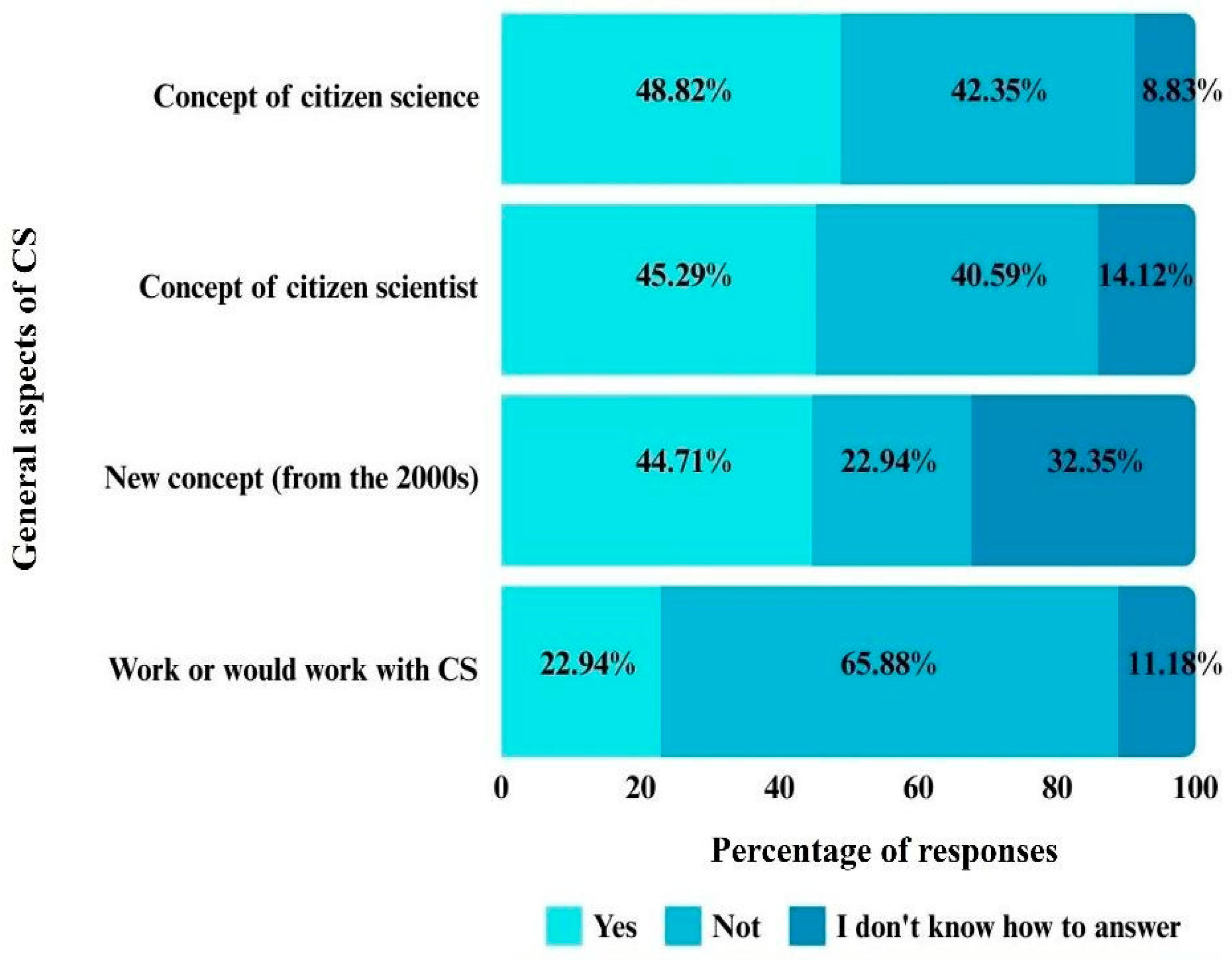

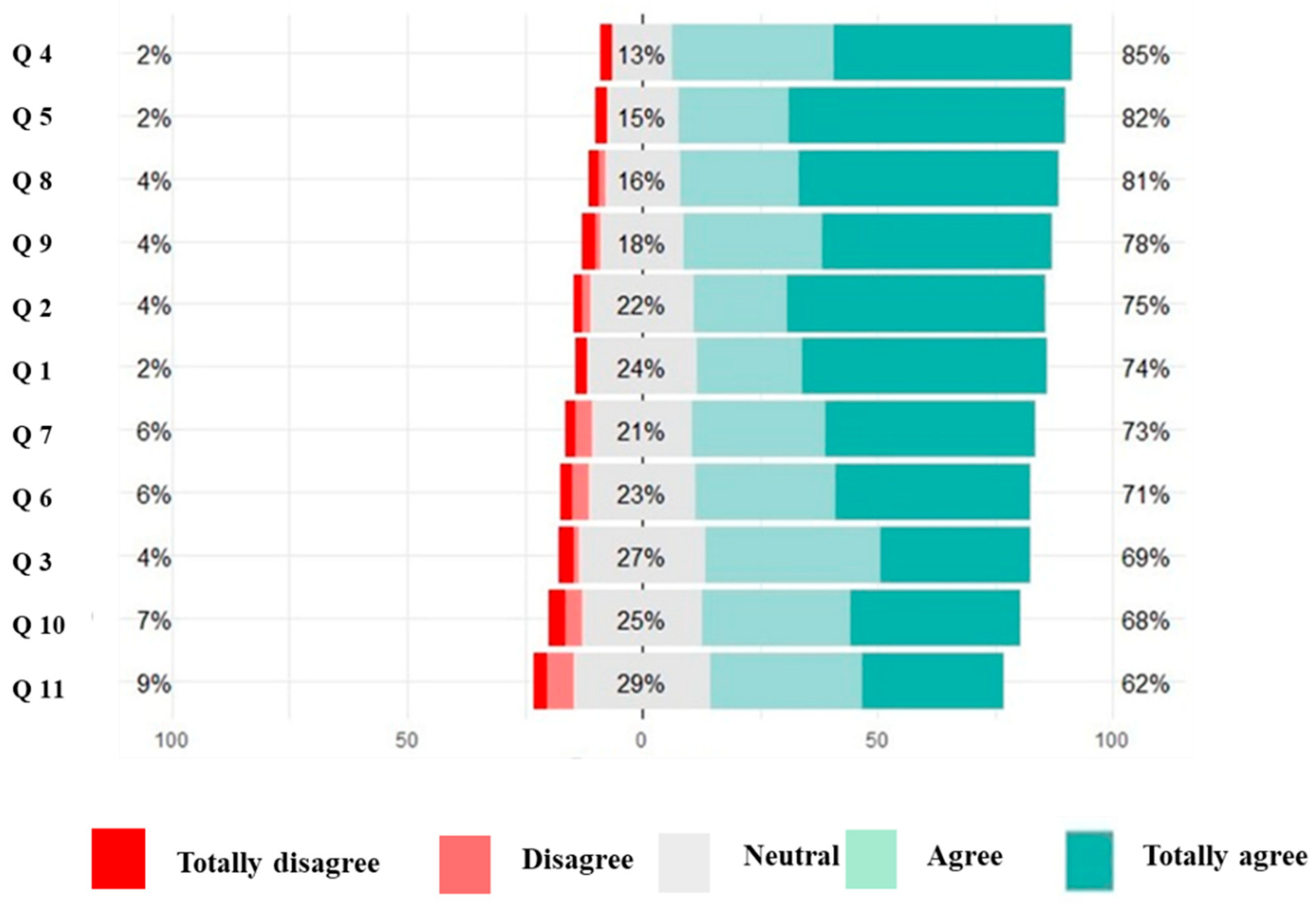
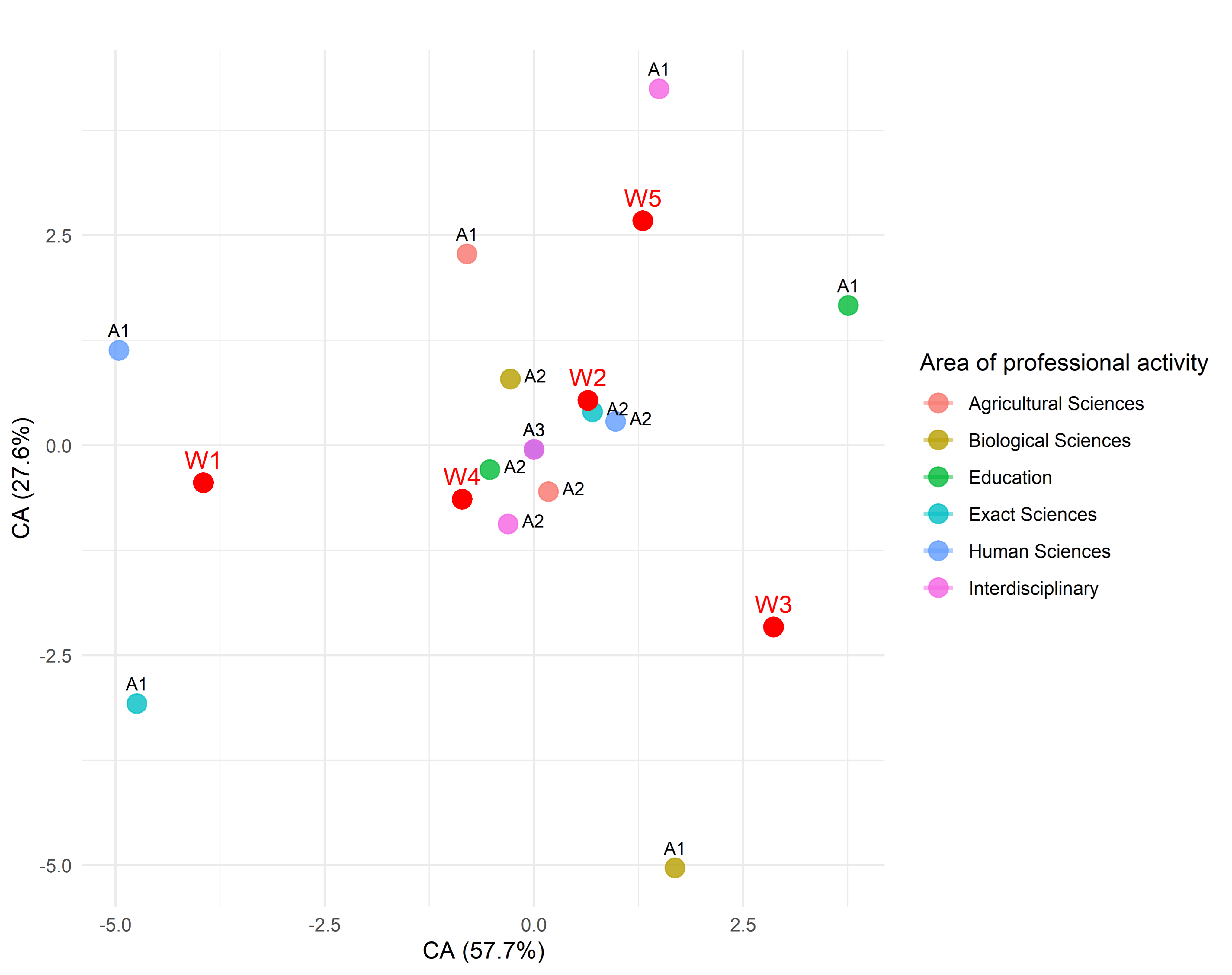



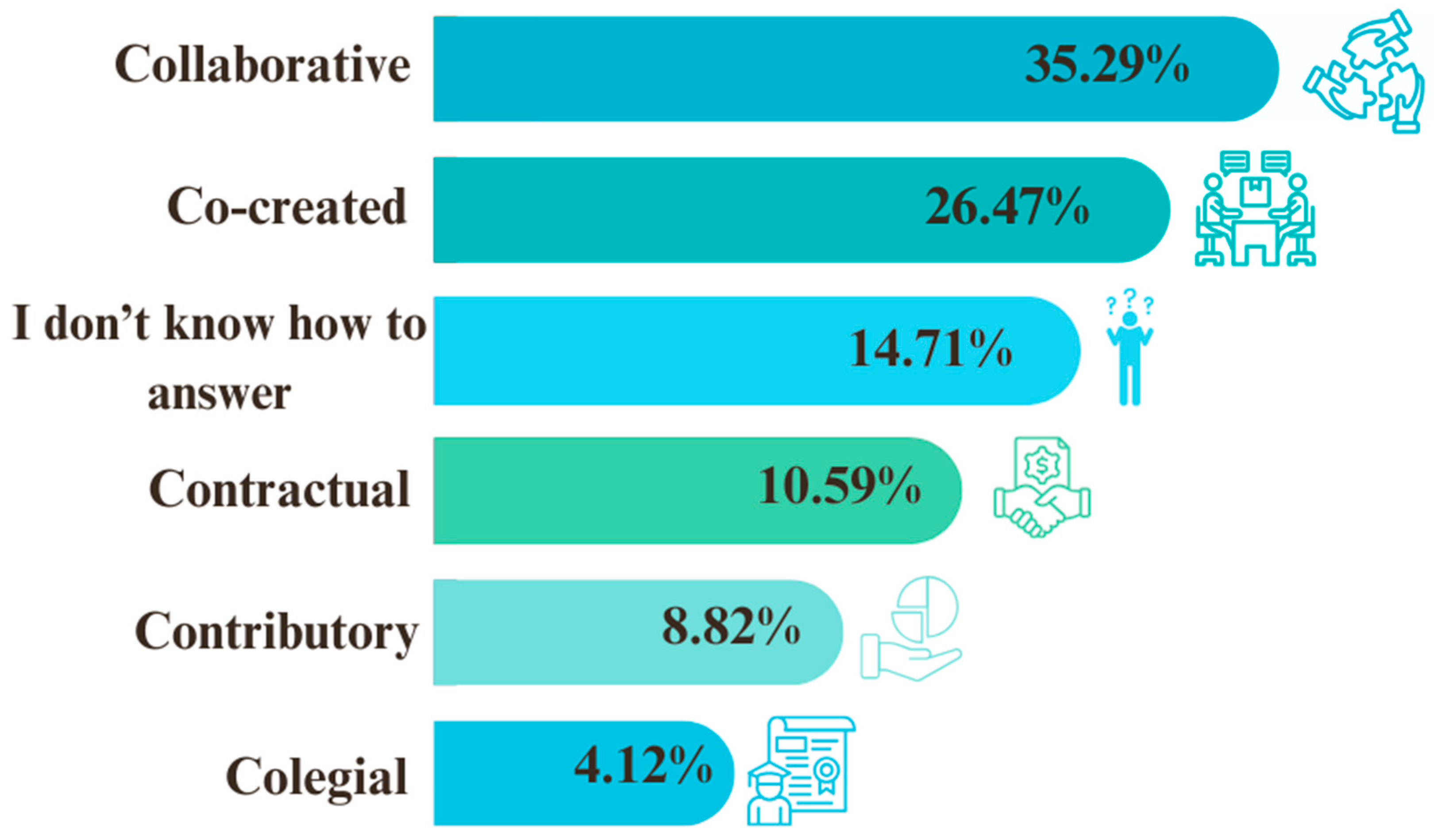
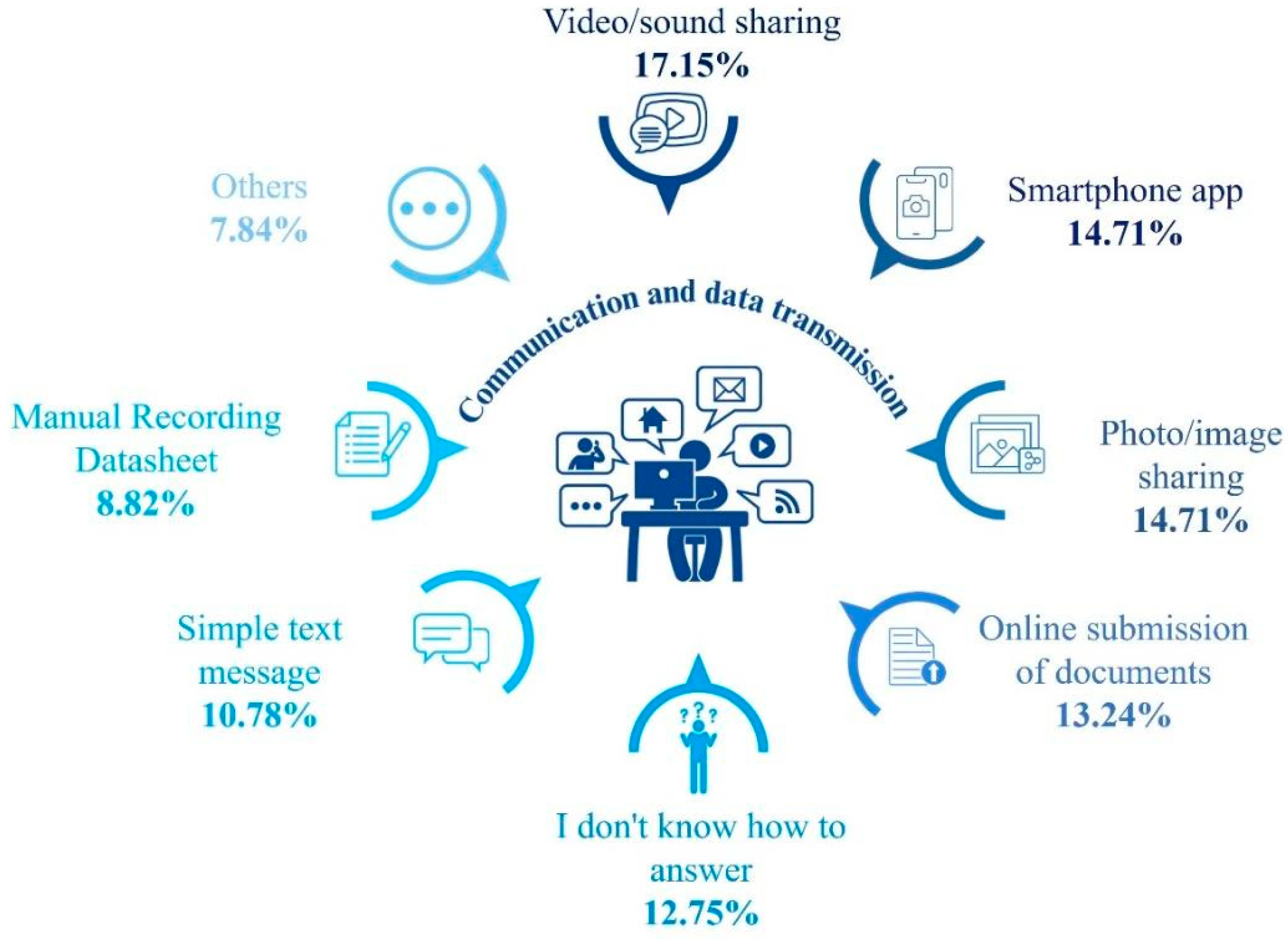

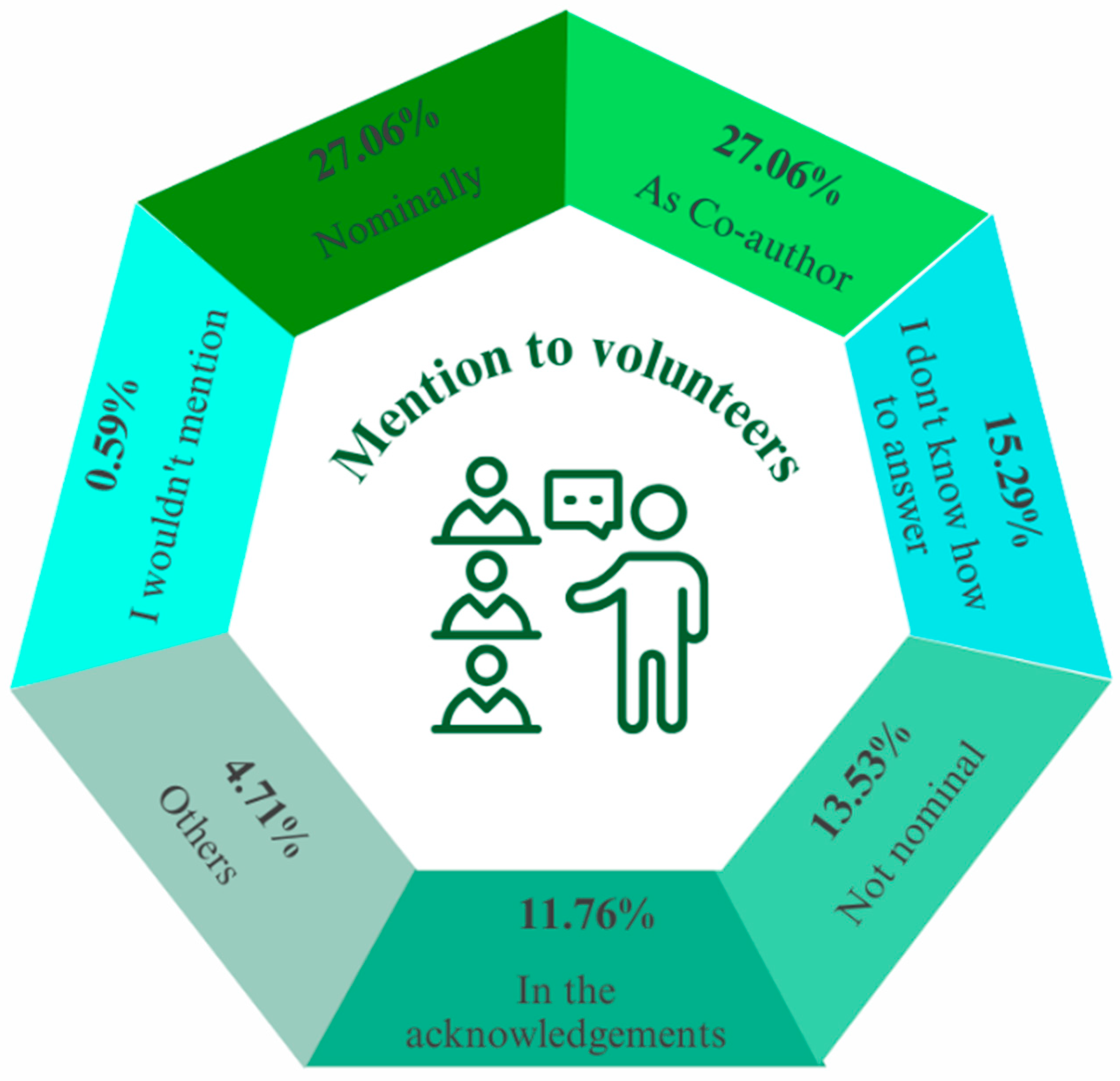
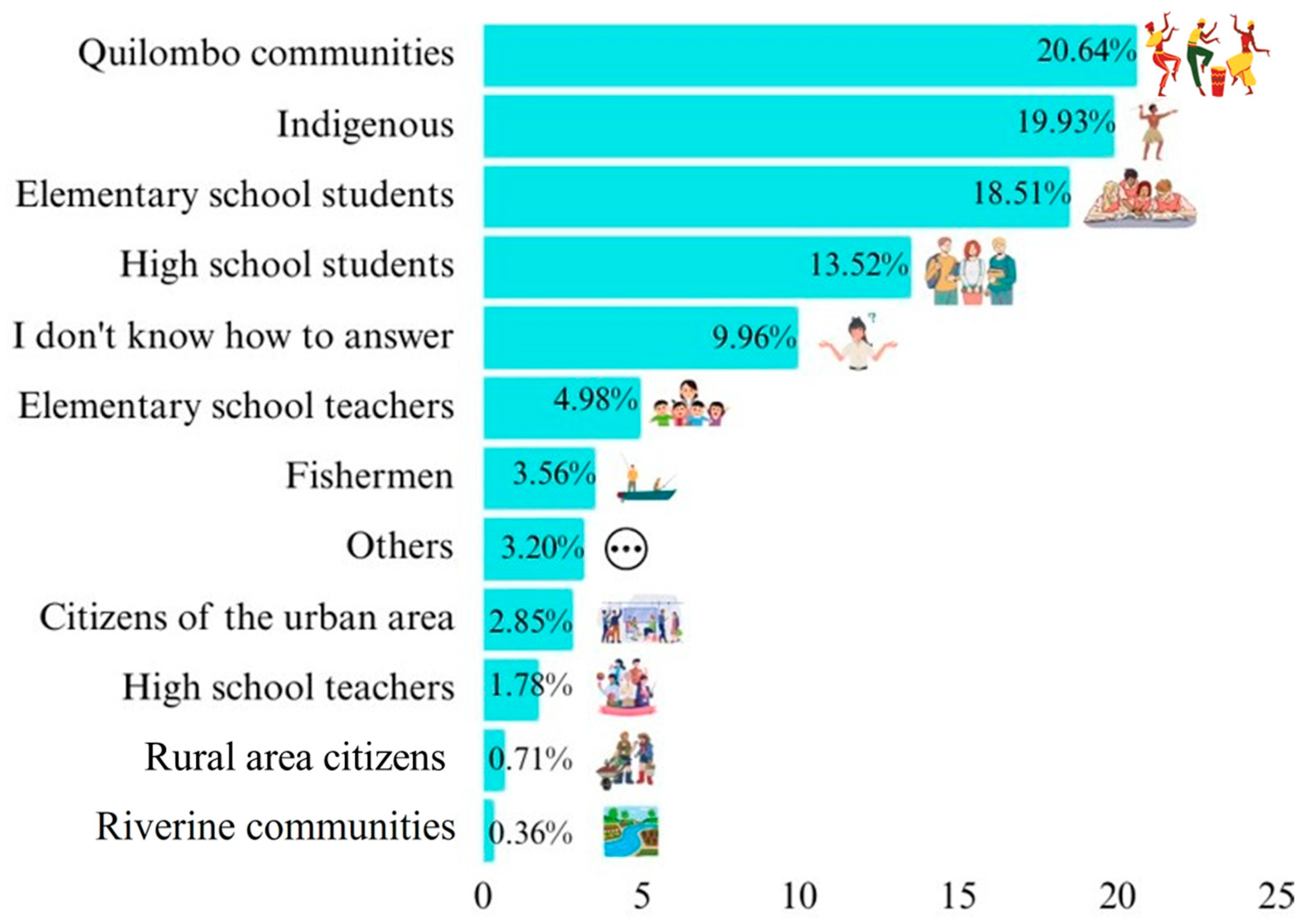
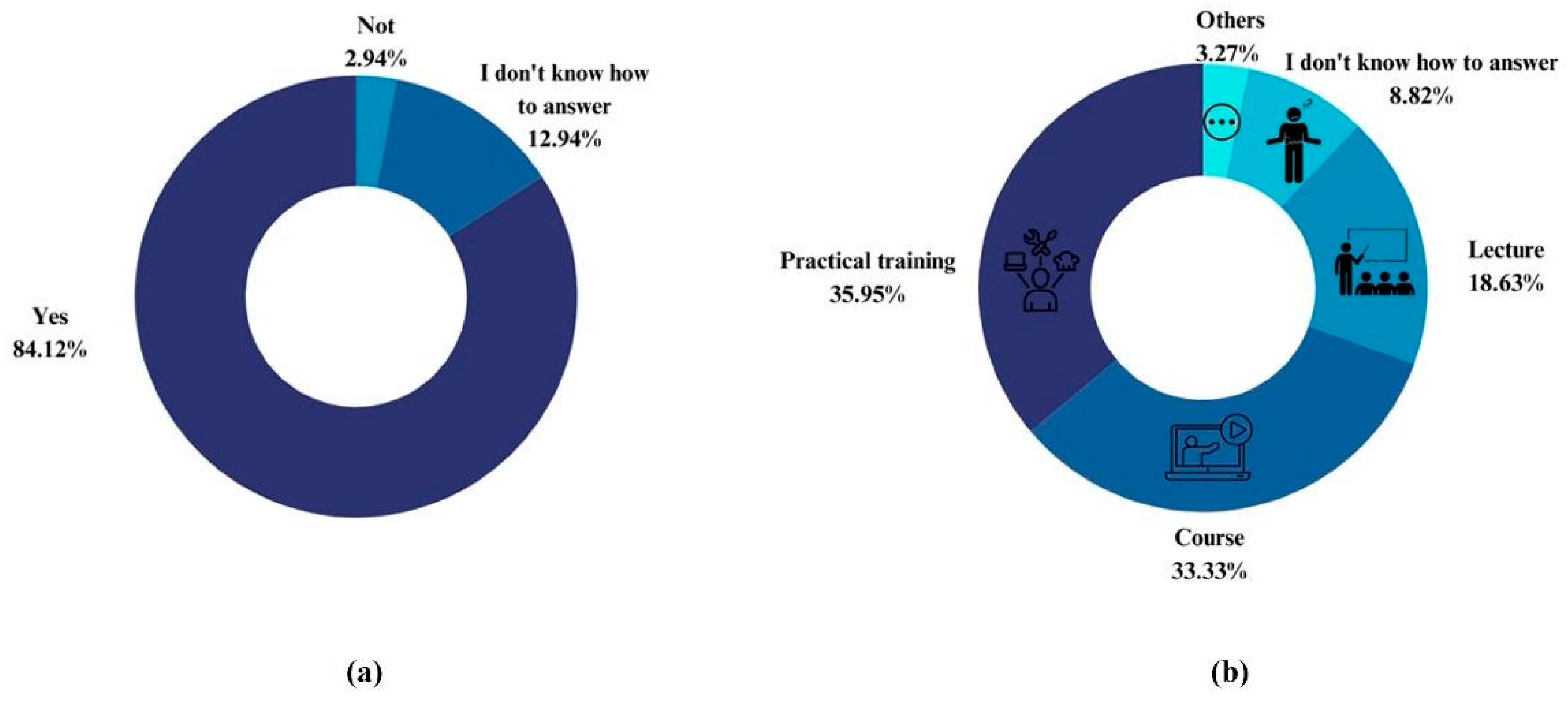

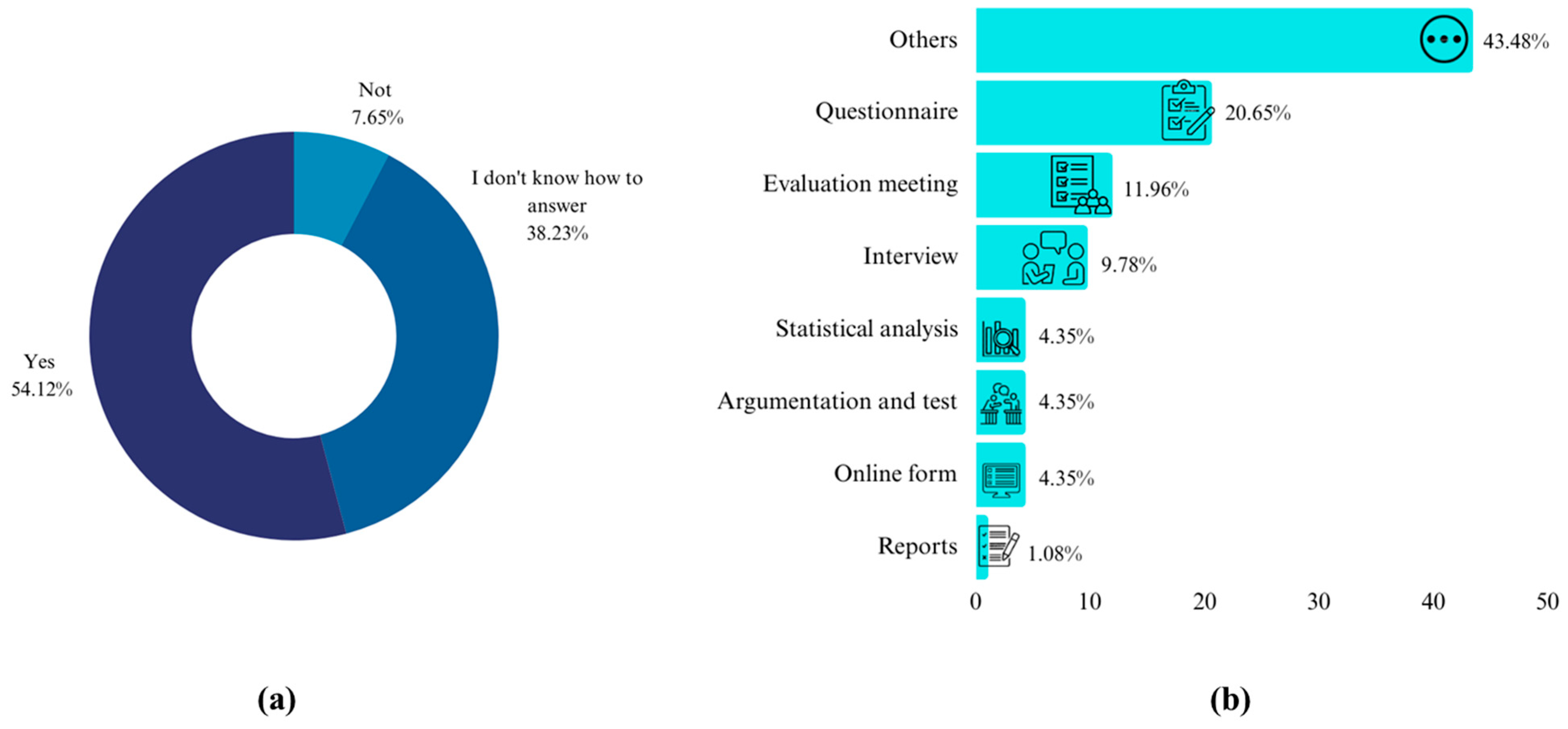
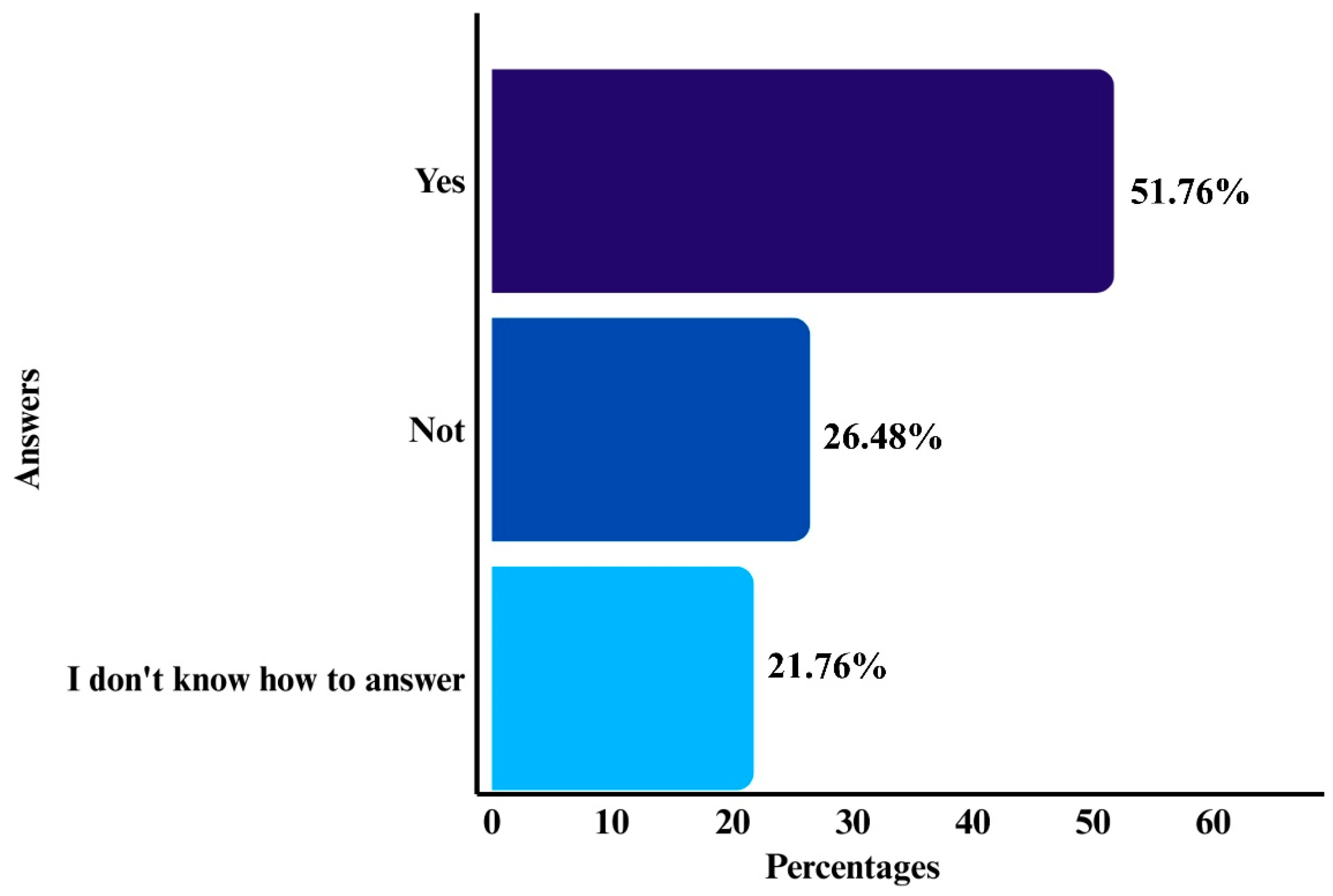
| Sociodemographic Variables | Socioprofessional Variables | ||||
|---|---|---|---|---|---|
| Individuals | Individuals | ||||
| N | % | N | % | ||
| Sex | Degree | ||||
| Male | 83 | 48.82 | Master’s Degree | 23 | 13.53 |
| Female | 87 | 51.18 | Doctorate | 147 | 86.47 |
| Total | 170 | 100 | Total | 170 | 100 |
| Age group (in years) | Area of expertise | ||||
| 25–34 | 17 | 10.00 | |||
| 35–44 | 81 | 47.64 | Agricultural Sciences | 12 | 7.06 |
| 45–54 | 47 | 27.65 | Environmental Sciences | 3 | 1.76 |
| 55–64 | 19 | 11.18 | Biological Sciences | 27 | 15.88 |
| >65 | 6 | 3.53 | Health Sciences | 27 | 15.88 |
| Total | 170 | 100 | Exact and Earth Sciences | 17 | 10.00 |
| Color/ethnicity | Human Sciences | 43 | 25.29 | ||
| Asian | 3 | 1.76 | Applied Social Sciences | 14 | 8.24 |
| White | 100 | 58.82 | Computing | 1 | 0.6 |
| Indigenous | 1 | 0.6 | Engineering | 10 | 5.88 |
| Black | 13 | 7.65 | Interdisciplinary | 10 | 5.88 |
| Mixed race | 50 | 29.41 | Linguistics, Literature, and Arts | 6 | 3.53 |
| I prefer not to say | 3 | 1.76 | |||
| Total | 170 | 100 | Total | 170 | 100 |
Disclaimer/Publisher’s Note: The statements, opinions and data contained in all publications are solely those of the individual author(s) and contributor(s) and not of MDPI and/or the editor(s). MDPI and/or the editor(s) disclaim responsibility for any injury to people or property resulting from any ideas, methods, instructions or products referred to in the content. |
© 2025 by the authors. Licensee MDPI, Basel, Switzerland. This article is an open access article distributed under the terms and conditions of the Creative Commons Attribution (CC BY) license (https://creativecommons.org/licenses/by/4.0/).
Share and Cite
Lameira, H.L.N.; Guerrero-Moreno, M.A.; Silva, E.C.; Santos, P.R.B.; Teodósio, M.A.; Oliveira-Junior, J.M.B. Citizen Science from the Perspective of Higher Education Professors. Educ. Sci. 2025, 15, 738. https://doi.org/10.3390/educsci15060738
Lameira HLN, Guerrero-Moreno MA, Silva EC, Santos PRB, Teodósio MA, Oliveira-Junior JMB. Citizen Science from the Perspective of Higher Education Professors. Education Sciences. 2025; 15(6):738. https://doi.org/10.3390/educsci15060738
Chicago/Turabian StyleLameira, Helton Luis Nina, Mayerly Alexandra Guerrero-Moreno, Everton Cruz Silva, Paulo Roberto Brasil Santos, Maria Alexandra Teodósio, and José Max Barbosa Oliveira-Junior. 2025. "Citizen Science from the Perspective of Higher Education Professors" Education Sciences 15, no. 6: 738. https://doi.org/10.3390/educsci15060738
APA StyleLameira, H. L. N., Guerrero-Moreno, M. A., Silva, E. C., Santos, P. R. B., Teodósio, M. A., & Oliveira-Junior, J. M. B. (2025). Citizen Science from the Perspective of Higher Education Professors. Education Sciences, 15(6), 738. https://doi.org/10.3390/educsci15060738









